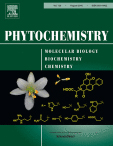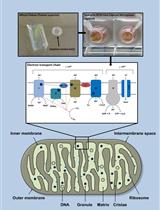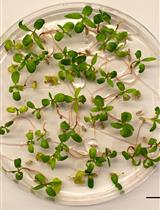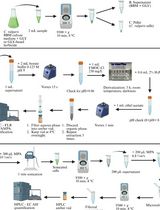- EN - English
- CN - 中文
Chromatographic Separation of the Codonocarpine Type Alkaloids from the Root Bark of Capparis decidua
凯尔树根皮中Codonocarpine型生物碱的色谱法分离
发布: 2017年02月20日第7卷第4期 DOI: 10.21769/BioProtoc.2144 浏览次数: 8390
评审: Arsalan DaudiMing LuoMagdalena Migocka
Abstract
Various parts of the caper tree Capparis decidua have found application in traditional medicine. The isolation and structural elucidation of the codonocarpine type alkaloids contained in the root bark, however, is not trivial and has probably led to misinterpretation in the past. This protocol describes the extraction and chromatographic separation of the four major alkaloids of the root bark of Capparis decidua. The delivered samples of cadabicine, codonocarpine, isocodonocarpine and capparidisinine were suitable for their unambiguous structural elucidation by NMR, MS and MS/MS.
Keywords: Capparis decidua (凯尔树)Background
The tree Capparis decidua is widely distributed in the arid regions of Africa, the Middle East and Southern Asia, where various parts of the plant are commonly used in local folk medicines for the treatment of various disorders. The root bark, for example, is applied as anthelmintic and purgative, and it has been shown that its alcoholic extract possesses significant antibacterial and antifungal activities (Singh et al., 2011; Singh and Singh, 2011; Tlili et al., 2011; Mohammed et al., 2015).
Ahmad et al. (1985; 1986; 1987; 1989; Arif, 1986) intensively studied the root bark extract of Capparis decidua and published several structures of codonocarpine type alkaloids. Some of these structures did not fit with our understanding of the biosynthesis of such alkaloids. Further, we were not convinced that the given analytic data and its interpretation gives unambiguous proof for the structural claims (Bienz et al., 2002). Therefore, we initiated our own investigation. We developed a protocol for the extraction and chromatographic separation of codonocarpine type alkaloids and could isolate three alkaloid fractions that allowed the identification and structural elucidation of the four major spermidine alkaloids of the root bark of Capparis decidua: cadabicine (1), codonocarpine (2), isocodonocarpine (3), and capparidisinine (4) (Figure 1) (Forster et al., 2016). 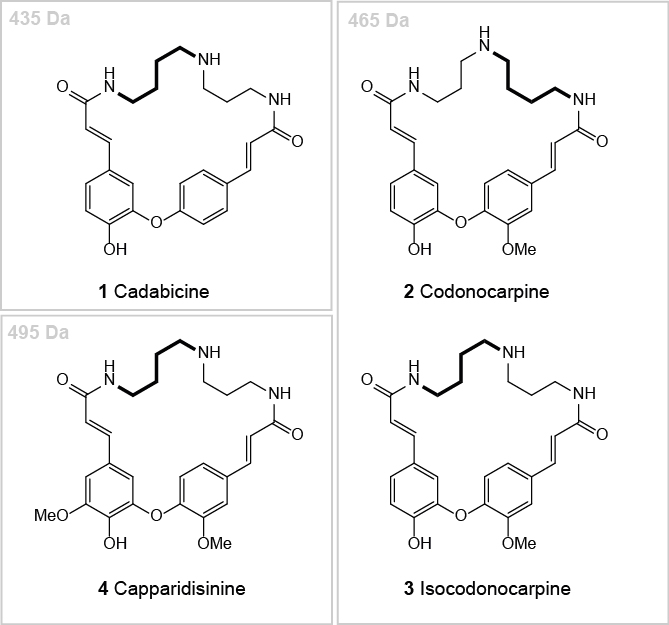
Figure 1. The four major codonocarpine type alkaloids found in the root bark of Capparis decidua. (1) Cadabicine; (2) Codonocarpine; (3) Isocodonocarpine; and (4) Capparidisinine.
The isolation and structure elucidation of alkaloids is not trivial. The class of alkaloids, defined as nitrogen containing organic compounds from natural sources with a most basic character, comprises more than 10,000 compounds. As the properties and structures of alkaloids differ strongly from compound to compound, there is no general way to isolate them. Nevertheless, most alkaloids exist naturally in their protonated form. Hence, the methanolic extraction of dried and crushed plant material is often applied. As alkaloids usually possess amino and other functional groups that could react with solvents and additives, as well as with CO2 or oxygen from air, the formation of artefacts is prevented as far as possible by the choice of appropriate conditions. In general, artefacts can be recognized by comparing the analytical data of the isolated fractions and the original sample. Therefore, some of the original sample should always be kept as reference material (Hesse, 2000).
Materials and Reagents
- Cotton wool (e.g., Thomas Scientific, catalog number: 2904W25 )
- Sea sand (cristobalite, Brenntag Schweizerhall AG) (e.g., Grogg Chemie, catalog number: G890 )
- Round bottom test tubes, ca. 100 x 16 mm (Assistant, catalog number: 42775045 )
- TLC plates (TLC Silica gel 60 F254 on aluminum 20 x 20 cm) (EMD Millipore, catalog number: 100390 )
- Glass capillaries (MARCHEREY-NAGEL, catalog number: 814022 )
- 2 ml 9 mm ScreVial, clear glass 12 x 32 mm (Infochroma, catalog number: G004-HP-H )
- 9 mm screw cap with 1 mm pigment-free ms-pure PTFE/Silicone/PTFE-Septum (Infochroma, catalog number: G004-HP-CB-FKSKFK10 )
- 1.5 ml Eppendorf tubes (Eppendorf, catalog number: 0030120086 )
- Plant material: Capparis decidua root bark (collected in Sahiwal, Pakistan and identified by M. Waris, Department of Cholistan Institute of Desert Studies, The Islamia University of Bahawalpur, Pakistan)
- MeOH (methanol, technical grade, distilled prior to use) (Thommen Furler, catalog number: 203-VL54TE )
- SiO2 (Merck silica gel 60 [40-63 μm]) (EMD Millipore, catalog number: 109385 )
- Ammonium hydroxide (NH3, aqueous ammonia solution 25%, puriss p.a.) (Honeywell, catalog number: 30501 )
- Chloroform (CHCl3, stabilized with EtOH) (Scharlab, catalog number: CL02181000 )
- Dichloromethane (CH2Cl2, technical grade, distilled prior to use) (Thommen-Furler, catalog number: 739-VL54TE )
- Diethylether (Et2O, puriss. p.a., stabilized with BTH, distilled from NaOH prior to use) (Honeywell, catalog number: 32203 )
Notes: - Pure ether is sensitive towards oxidation and can form explosive peroxides upon prolonged exposure to air and light. It therefore is usually stabilized with the antioxidant butylhydroxytoluene (BHT), which is removed upon distillation. Thus, distilled ether is again prone to form epoxides, and it is necessary to test your distilled ether for peroxides prior to its use if the solvent was exposed to air and light for several days.
- To test for peroxides use: Quantofix® peroxides test sticks (Sigma-Aldrich, catalog number: Z101680 ).
- Methylamine solution (MeNH2, 40 wt. %) (Sigma-Aldrich, catalog number: 426466 )
- Hydrochloric acid (HCl, 37%) (for analysis, Merck) (EMD Millipore, catalog number: 100317 )
- Acetonitrile (MeCN, LC-MS Ultra CHROMASOLV®) (Honeywell, catalog number: 14261 )
- Formic acid (HCO2H, 99%, ULC/MS) (Biosolve, catalog number: 069141 )
- 2-propanol (LC-MS Ultra CHROMASOLV®) (Honeywell, catalog number: 650447 )
- Sodium hydroxide solution (NaOH for HPCE, 0.1 N in H2O) (e.g., MSP KOFEL, catalog number: 5062-8575 )
- H2PtCl6
- KI
- Ce(SO4)2
- H2SO4
- Schlittler reagent (see Recipes)
- Ce(SO4)2 solution (see Recipes)
Equipment
- Sharp axe (e.g., TRANSA, catalog number: 040929-001001 )
- Capped fermentation tank (50 L, e.g., Braupartner, catalog number: 141-0 )
- Filter strainer cloth (75 x 75 cm, e.g., Erwin Müller, catalog number: i10014278 )
- Stainless steel spatula (e.g., Thomas Scientific, catalog number: 1232X12 )
- Rotary evaporator (Büchi Rotavapor R-134 with Büchi Waterbath B-481) (Büchi, Flawil, Switzerland)
- Glass funnels (e.g., Duran, catalog number: 21 351 23 )
- Round bottom flasks of several sizes (5 ml, 10 ml, 25 ml, 50 ml, 250 ml, 1 L) (e.g., Schott, Germany)
- Steel spring clips (e.g., Thomas Scientific)
NS 14.5 (e.g., Thomas Scientific, catalog number: 1178Z55 )
NS 29 (e.g., Thomas Scientific, catalog number: 1178Z57 ) - Magnetic stir bars (e.g., Thomas Scientific, catalog number: 8608S78 )
- Magnetic stirrer (Heidolph Instrument, catalog number: 505-30080-00 )
- Glass bottle 1 L (e.g., Thomas Scientific, catalog number: 1228R95 )
- Glass chromatography columns of different length and diameters with stopcock at the bottom and a ground socket joint at the top to fit a solvent reservoir (e.g., Neubert Glas, catalog number: 1196-29-20400 )
- Glass beaker of several sizes (e.g., Duran, Germany)
- A piece of vacuum hose (e.g., Thomas Scientific, catalog number: 9544T15 )
- Solvent reservoirs: glass round bottom flasks of several sizes with oppositely attached ground cone and ground socket joints (e.g., Thomas Scientific, catalog number: 1197C03 )
- Adaptors:
Ground cone joint NS 14.5 with hose barbe to tubing, bent (e.g., Thomas Scientific, catalog number: 1195C09 )
Ground cone joint NS 29 with hose barbe to tubing, bent (e.g., LabMarket, catalog number: 1681029 ) - Hand pump (VWR, catalog number: 612-9952 )
- 125 ml Erlenmeyer flasks (e.g., Thomas Scientific, catalog number: 4907F23 )
- Test tube racks (e.g., Thomas Scientific)
- TLC chamber (screw cap glass jar, 250 ml)
- UV lamp (254 nm), e.g., UV lamp 4, dual (Camag, model: 022.9160 )
- High vacuum pump (Alcatel Pascal 2015 SD) (e.g., Ideal Vaccum Products, catalog number: P102310 )
- CortecsTM UPLC® C18+, 1.6 μm, 2.1 x 150 mm (Waters, catalog number: 186007117 ), equipped with a CortecsTM UPLC® C18+ 1.6 μm, 2.1 x 5 mm VanGuardTM precolumn (Waters, catalog number: 186008713 )
- AquityTM Ultra Performance LC (Waters, Milford MA, USA)
- Bruker maXis Q-Tof HR-MS (Bruker Daltonics, Bremen, Germany)
- Eppendorf refrigerated microcentrifuge (Eppendorf, model: 5417R )
- MilliQ gradient apparatus (deionized water, for HPLC) (EMD Millipore, catalog number: Z00Q0V0WW )
Procedure
文章信息
版权信息
© 2017 The Authors; exclusive licensee Bio-protocol LLC.
如何引用
Forster, Y., Ghaffar, A. and Bienz, S. (2017). Chromatographic Separation of the Codonocarpine Type Alkaloids from the Root Bark of Capparis decidua. Bio-protocol 7(4): e2144. DOI: 10.21769/BioProtoc.2144.
分类
植物科学 > 植物生物化学 > 其它化合物
植物科学 > 植物生理学 > 新陈代谢
生物化学 > 其它化合物 > 生物碱
您对这篇实验方法有问题吗?
在此处发布您的问题,我们将邀请本文作者来回答。同时,我们会将您的问题发布到Bio-protocol Exchange,以便寻求社区成员的帮助。
Share
Bluesky
X
Copy link





